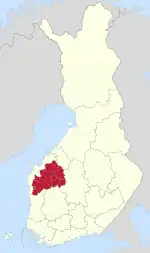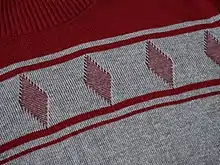South Ostrobothnia
South Ostrobothnia[1] (Finnish: Etelä-Pohjanmaa; Swedish: Södra Österbotten) is one of the 19 regions of Finland. It borders the regions of Ostrobothnia, Central Ostrobothnia, Central Finland, Pirkanmaa, and Satakunta. Among the Finnish regions, South Ostrobothnia is the ninth largest in terms of population.[2] Seinäjoki is the regional centre[3] and by far the largest city in the area.[4]
South Ostrobothnia
| |
|---|---|
| Region of South Ostrobothnia Etelä-Pohjanmaan maakunta Landskapet Södra Österbotten | |
 Flag  Coat of arms | |
 South Ostrobothnia on a map of Finland | |
| Coordinates: 62°45′N 22°30′E | |
| Country | Finland |
| Historical province | Ostrobothnia, Satakunta |
| Capital | Seinäjoki |
| Area | |
| • Total | 13,999.63 km2 (5,405.29 sq mi) |
| Population (2021) | |
| • Total | 191,762 |
| • Density | 14/km2 (35/sq mi) |
| ISO 3166 code | FI-03 |
| NUTS | 194 |
| Regional animal | Red squirrel (Sciurus vulgaris) |
| Regional bird | Eurasian curlew (Numenius arquata) |
| Regional fish | European whitefish (Coregonus lavaretus) |
| Regional flower | Fireweed (Epilobium angustifolium) |
| Regional stone | Impactite |
| Regional lake | Lake Lappajärvi |
| Website | etelapohjanmaa.fi |
As a cultural area, South Ostrobothnia is larger than its current regional borders and includes the region of Ostrobothnia as well.[3]
Historical provinces
Municipalities
The region of South Ostrobothnia is made up of 18 municipalities, of which eight have city status (marked in bold).
|
Järviseutu sub-region:
Kuusiokunnat sub-region: |
Suupohja sub-region:
|
Demographics
| Year | Pop. | ±% |
|---|---|---|
| 1972 | 200,137 | — |
| 1975 | 196,746 | −1.7% |
| 1980 | 201,152 | +2.2% |
| 1985 | 206,209 | +2.5% |
| 1990 | 207,010 | +0.4% |
| 1995 | 206,136 | −0.4% |
| 2000 | 200,766 | −2.6% |
| 2005 | 198,856 | −1.0% |
| 2010 | 198,469 | −0.2% |
| 2015 | 197,371 | −0.6% |
| 2020 | 192,150 | −2.6% |
| 2021 | 191,762 | −0.2% |
| Source: Statistics Finland | ||
South Ostrobothnia is the most homogenous region in Finland, with the highest share of the population speaking Finnish (97.1%) and the lowest share of people with a foreign-background (2.7%). Swedish is spoken by 637 people (0.3%). The highest shares of Swedish-speakers are in Evijärvi (2%) and Karijoki (1.6%), both of which border majority Swedish-speaking municipalities in the region of Ostrobothnia. The most spoken immigrant languages are Russian (0.5%), Estonian (0.4%), Ukrainian (0.2%), Hungarian (0.2%) and Thai (0.1%).[5]
South Ostrobothnia has the highest proportion of people who belong to the Evangelical Lutheran Church of Finland out of any region, at 82.8%. It also has the fourth highest dependency ratio at 74.3, higher than the national average of 62.4. The region has a higher proportion of people aged 0-14 and those aged 65 and over than the national average. The proportion of people in the working age (aged 15-64) is one of the lowest in the country.[6] Kauhajoki in South Ostrobothnia is estimated to have the highest proportion of Finnish Kale in Finland, at 5%.[7] In 2019, the city of Seinäjoki became one of the first in the country to fly the Romani flag during International Romani Day.[8]
Population by background country as of 31 December 2021:[9]
 Finland 186,604 (97.31%)
Finland 186,604 (97.31%) Russia 1,026 (0.54%)
Russia 1,026 (0.54%) Estonia 636 (0.33%)
Estonia 636 (0.33%) Ukraine 291 (0.15%)
Ukraine 291 (0.15%) Hungary 286 (0.15%)
Hungary 286 (0.15%) Turkey 261 (0.14%)
Turkey 261 (0.14%) Thailand 254 (0.13%)
Thailand 254 (0.13%) Sweden 191 (0.10%)
Sweden 191 (0.10%) Poland 135 (0.07%)
Poland 135 (0.07%) Iraq 130 (0.07%)
Iraq 130 (0.07%) Myanmar 129 (0.07%)
Myanmar 129 (0.07%) Romania 110 (0.06%)
Romania 110 (0.06%)
Other 1,709 (0.89%)
Culture

Regional and historical sub-tribal identity is generally stronger in South Ostrobothnia than in most regions of Finland.[10]
The South Ostrobothnian dialect belongs to the western Finnish dialects.[11] However, in the most eastern part of the region people speak a Savonian dialect that has Ostrobothnian elements.[12]
One of the biggest rock festivals in Finland, Provinssirock, and the world's oldest tango festival Tangomarkkinat are both held in Seinäjoki.[3] The folk music festival Eteläpohjalaiset Spelit is held annually in different South Ostrobothnian locations[13] and the opera and music festival Ilmajoen Musiikkijuhlat is held in Ilmajoki.[14] Many of the cultural events in South Ostrobothnia are rooted in local folk festivals and communal work.[15]
There are several local folk costumes.[16] Jussipaita is a traditional sweater that has become a symbol for South Ostrobothnian identity.[17]
Notable architecture in South Ostrobothnia include the Lakeuden Risti Church and other buildings in the Aalto Centre in Seinäjoki designed by the South Ostrobothnian-born architect Alvar Aalto.[18] A traditional peasant house, ”pohjalaistalo” (Ostrobothnian house), is a part of the local folk culture.[19]

South Ostrobothnia is known for its agriculture and animal husbandry. Traditional local cuisine include leipäjuusto and kropsu, an Ostrobothnian pancake.[20]
Politics
Results of the 2019 Finnish parliamentary election in South Ostrobothnia:
- Centre Party 31.66%
- Finns Party 22.02%
- National Coalition Party 17.64%
- Social Democratic Party 10.79%
- Christian Democrats 6.39%
- Green League 4.22%
- Left Alliance 2.81%
- Blue Reform 1.82%
- Swedish People's Party 0.41%
- Seven Star Movement 0.37%
- Other parties 1.87%
References
- "Luokitus: Maakunnat 2022 | Tilastokeskus".
- https://www.epliitto.fi/vakiluku (in Finnish)
- "Etelä-Pohjanmaata ja pohjalaisia | Elävä arkisto | yle.fi". yle.fi (in Finnish). Retrieved 2021-04-11.
- "Väestö". Etelä-Pohjanmaan liitto (in Finnish). Retrieved 2022-03-25.
- "Language according to age and sex by region, 1990-2021". stat.fi. Retrieved 24 January 2023.
- "Key figures on population by region, 1990-2021". stat.fi. Retrieved 24 January 2023.
- "Romanit hajautuneet kuten valtaväestökin – Kauhajoki on Suomen suurin romanipitäjä". yle.fi (in Finnish). Retrieved 24 January 2023.
- "Monien vieroksuma lippu nousee Seinäjoen kaupungin salkoon romanien kansallispäivänä – romaniaktiivi: "Olen aivan hämmentynyt"". yle.fi (in Finnish). Retrieved 24 January 2023.
- "Origin and background country according to age group and sex by region, 1990-2021". stat.fi. Retrieved 24 January 2023.
- "Studies on Finnish attitudes and identities | The Finnish Cultural Foundation". skr.fi. Retrieved 2021-04-11.
- "Suomen murteet". Kotimaisten kielten keskus (in Finnish). Retrieved 2022-03-22.
- Tervonen, Riikka. "Järviseudun murre – itäinen kiila pohjalaismurteiden välissä". Katternö Digital (in Finnish). Retrieved 2022-03-22.
- Pirkko, Kotirinta (1994-07-01). "Eteläpohjalaisia Spelejä soitetaan nyt Jalasjärvellä". Helsingin Sanomat (in Finnish). Retrieved 2022-03-23.
- "Ilmajoen musiikkijuhlat - Visit Ilmajoki" (in Finnish). Retrieved 2022-03-22.
- Etelä-Pohjanmaan liitto (2014): Etelä-Pohjanmaa − Jotakin parempaa – Etelä-Pohjanmaan kulttuuristrategia vuosille 2015–2020, pp. 5–9.
- "Etelä-Pohjanmaan kansallispuvut – Etelä-Pohjanmaan Nuorisoseura" (in Finnish). Retrieved 2022-03-22.
- Luutonen, Marketta (2008): Harrin Jussin muisto: Jussipaita suomalaismiehen rooliasuna Oppimista, opetusta, monitieteisyyttä - Kirjoituksia Kuninkaankartanonmäeltä. Joensuun yliopisto, Savonlinnan opettajankoulutuslaitos.
- Niemistö, Elina (2020-12-29). "Moni vieroksui Alvar Aaltoa, eikä "funkkislaatikko" ollut kelvata kirkoksi – pohjalaisesta uhosta syntyi kuitenkin Lakeuden risti". Yle Uutiset (in Finnish). Retrieved 2022-03-22.
- Riukulehto, Sulevi; Mäkelä, Matti; Orhanen, Outi & Lehtimäki, Anni: Pohjalaistalot – yhteistä kulttuuriperintöämme. Helsingin yliopisto, Ruralia-instituutti, 2014.
- "Maakuntien ruokaperinteitä". Ruokatieto Yhdistys. Retrieved 2022-03-23.